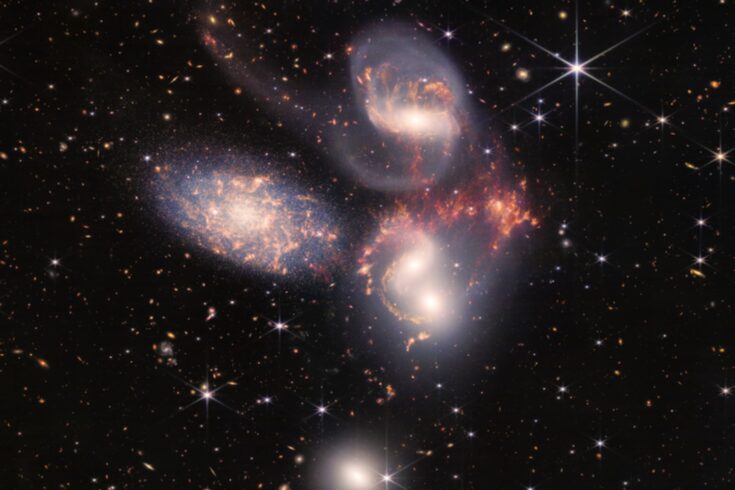Results from WEAVE reveal the previously unknown dual nature of the shock generated by the galaxy NGC 7318b as it slammed into Stephan’s Quintet at over 2 million miles per hour (mph).
Led by the University of Hertfordshire, the team combined WEAVE data with observations from other powerful instruments including the Low Frequency Array (LOFAR), the Very Large Array and the James Webb Space Telescope.
The ideal testbed
The nearby galaxy group Stephan’s Quintet has captivated astronomers since its discovery in 1877.
Past collisions between galaxies have left behind a complex field of cosmic debris, making it the ideal testbed to study the chaotic and violent interactions between galaxies, and an ideal target for first-light observations from WEAVE.
As the immense shockwave moves through cold gas in the region, its speed is strong enough to tear electrons from their atoms, leaving behind a glowing trail of charged gas.
Yet, when it travels through regions of hot gas, it becomes much weaker and produces radio waves detectable by telescopes like LOFAR.
Measuring distant galaxies
Led by RAL Space and the University of Oxford, the European consortium behind WEAVE has spent over a decade bringing this instrument to life.
They have developed its remarkable ability to capture high-resolution images and analyse light from nearly 1,000 celestial objects simultaneously.
It offers up to 10 times the precision of other spectrographs, allowing for detailed measurements of chemical elements in distant galaxies.
Just the beginning
These first results are just the beginning for WEAVE.
Over the next five years, the instrument will conduct a 1,200-night survey, collecting more than 12 million spectra.
This wealth of data will help map dark matter in the Milky Way, study galaxy evolution and explore the fascinating relationships between galaxies and their central black holes.
A huge achievement
Professor Gavin Dalton, WEAVE Principal Investigator at RAL Space and the University of Oxford, said:
These first science results from WEAVE represent a huge achievement for the entire consortium.
The instrument has been in development for over a decade, so it’s really rewarding to see it being used for remarkable science and fantastic to see the level of detail uncovered here.
As well as the details of the shock and the unfolding collision that we see in Stephan’s Quintet, these observations provide a remarkable perspective on what may be happening in the formation and evolution of the barely resolved faint galaxies that we see at the limits of our current capabilities.
This is only the beginning for WEAVE.
I’m excited to see what it will discover next.
High-impact result
Dr Marc Balcells, Director of the Isaac Newton Group of Telescopes, said:
I’m excited to see that the data gathered at the WEAVE first light already provide a high-impact result, and I’m sure this is just an early example of the types of discoveries that will be made possible with WEAVE on the William Herschel Telescope in the coming years.
WEAVE is operated by the Isaac Newton Group of Telescopes in La Palma, Spain.

